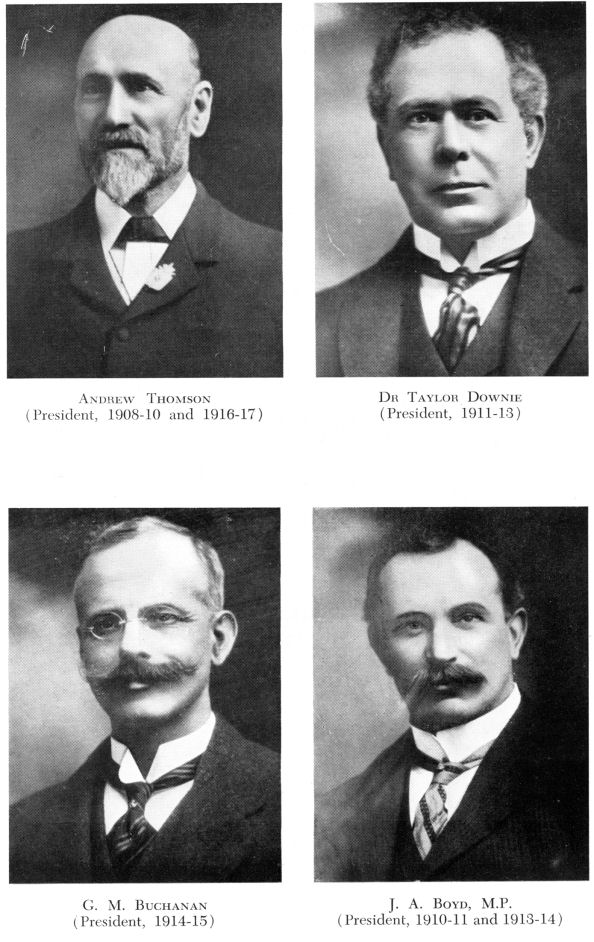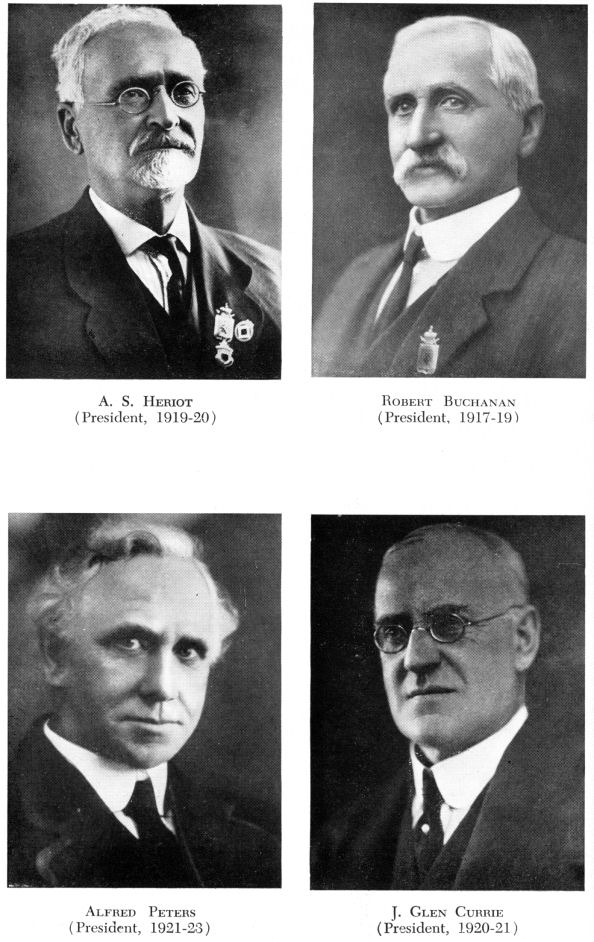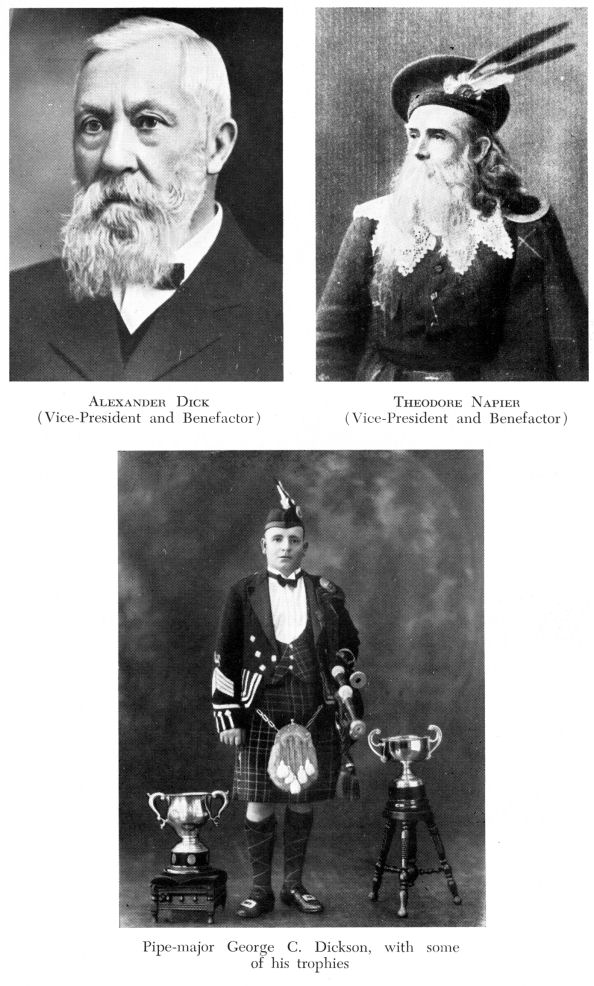|
Many Scottish singers appear
- "Excellent bioscope pictures" - Foundation of Victorian Scottish Union -
George Gibb as first President - J. S. Yorston's long service begins -
That word "English" again - Death of George Gibb - New Officers - Andrew
Thomson supports immigration.
WHAT a quandary Scottish
societies would be in if they lacked, for any length of time, a fair
supply W of entertainers! Actually, though, Victoria has always been well
off in this regard-the one group seems to have stimulated the other.
So it was at the turn of
the century. A Caledonian Brass Band (supported by the Melbourne Society)
was in full cry; the Caledonian Choir had discovered fresh vigour, and
Scottish singers in plenty were advertising their willingness to
appear-they included Misses Maggie McCann, Marguerite Henderson, Elsie
Liddelow, Jean Clarkson, Mabel Mattingley, Bessie Pelling, Lillian Adams,
Mrs W. E. Oldfield, Rufus Ferguson, and the humorous Ad Cree.
Concerts were, in fact,
very much a vogue of the day. That was before the advent of the radio and
the motion pictures, although, to be sure, at the annual meeting of the
Melbourne Caledonian Society in 1906 members enjoyed seeing some
"excellent bioscope pictures".
Sometimes the concerts were
of a complimentary nature. One in 1904, for example, was in the nature of
a benefit to the talented actress from Edinburgh, Eloise Juno, who had
done so well with the dramatic performances of Rob Roy. Another, given
later, realized £158 for Maggie McCann, the Scottish-born singer who had
charmed many audiences in Australia and who had decided to go abroad.
In addition, the Society
filled the Town Hall to overflowing in June of 1905 for a reception to the
celebrated Scottish singer Jessie Maclachlan. President Gibb was in
especially good form on that occasion, partly no doubt because of the
visitor's charm, and partly because Piper Robert Morrison had just
produced a new melody, "The George Gibb March". At any rate, the President
took Miss Maclachlan on his arm, in gallant style, to the Town Hall stage,
and afterwards presented her with the special medal of Society.
That medal, by the way, had
been struck by the Society in 1891. Examples had been presented only to
Sir Hector Macdonald and some few other special guests before Miss
Maclachlan's visit.
Concerts aside, the Society
went on with its Hallowe'en Festivals (usually for bairns ) and St
Andrew's Dinners. At one dinner of the period guests included the Lord
Mayor of Melbourne, Cr Pleasance (who said he highly appreciated "the
great debt which the City of Melbourne owed to Scotsmen"), Mr W. A. Watt,
Mr W. H. Irvine, and Sir John Forrest. At another such function, at which
the chief speaker was the Rev. P. J. Murdoch (father of Sir Keith
Murdoch), so much oratory developed that the report of the proceedings
spilled over nine pages of The Scot.
In view of all this
activity, it was not surprising that a suggestion arose for the forming of
a federation of Scottish societies. A hint on the point was given in The
Scot for April 1904 (it emphasized the need for a committee from various
societies to control dancing competitions, etc.), and the Rushworth
Caledonian Society, of which James Burt Stewart was Hon. Secretary,
promptly took up the matter and called a conference to consider it.
That convention, held at
the rooms of the Melbourne Caledonian Society-then at 31 Queen Street-on
2nd September 1904, marked the genesis of the Victorian Scottish Union.
Thirty-six delegates
attended the convention - a group photograph shows that Burt Stewart was
the only one lacking either whiskers or moustache-and the societies
represented were those of Melbourne (Caledonian and Thistle), Geelong,
Bendigo, Terang, Rushworth, Noorat, Hamilton, Mansfield, Drouin, Footscray,
and Williamstown. George Gibb was elected Chairman and Hector MacLennan
Hon. Secretary. The chief outcome of the meeting was a decision, sponsored
by Rushworth, for the forming of a Union of Scottish societies, details of
the scheme being left to a committee.
Later, delegates were
entertained at lunch by Mr Gibb and his fellow-officers, after which (says
The Scot), "with cheers for the Chairman and the Melbourne Society, one of
the most notable gatherings ever held by Scotsmen south of the Line broke
up".
A draft constitution for
the new body, formulated by the legal-minded Burt Stewart, was adopted at
a committee meeting held at 31 Queen Street on 4th November 1904 and
ordered to be presented to a later general meeting. It included
recommendations that the name of the new body should be the Victorian
Scottish Union, that its aims should be educational and benevolent, and
that the date of the establishment of the Union should be fixed by the
general conference.
Mr Stewart's scheme was
ratified at a meeting held in Melbourne on 8th September 1905. That date,
therefore, ranks as the birthday of the V.S.U. Practically all Scottish
societies in the State were represented at the meeting. Notable exceptions
were the Maryborough Highland Society (which appears to have overlooked
the matter) and the Hamilton Caledonian Society (which had developed a
mild grievance at the initial meeting). Both exceptions were regrettable,
for the Maryborough Society was the second oldest in the State and the
young Hamilton Society, under D. Laidlaw as Chief and A. P. Mackenzie as
Secretary, was strong and active.
At the first Council
meeting of the Union (November 1905) Mr Gibb was elected President, Mr
Stewart VicePresident, Mr H. J. Tait (Melbourne Thistle) Treasurer, and Mr
W. P. Jarvie Secretary pro tem. Messrs. D. R. S. Macgregor and J. S.
Yorston were appointed Auditors.
Not the least significant
choice was that of Mr Yorston. A native of Bressay (Shetland Isles) he had
reached Australia as a youth in 1898, and at the age of 26 had been
President of the South and Port Melbourne Thistle Club. Now, as a
foundation officer of the V.S.U., he was to begin long and honorable
service with that body, including periods as Treasurer, President and
Chief. Indeed, Jim Yorston was to be a highly useful citizen on several
counts as builder, municipal councillor, and champion of Scottish
affairs-and even when his sight failed, as it did in 1932, he retained his
energy, enthusiasm, and unfailing goodhumour in the discharge of public
duties.
In its first year of
existence the Scottish Union set its hand to three things in particular:
1-Regulating and controlling Scottish sports; 2-Establishing scholarships
for children of Scottish descent; 3-Attacking the use of the word
"English" for matters concerning the whole of Britain. In this
last-mentioned enterprise The Scot joined heartily: it asked Melbourne
daily newspapers (which had offended) what they would say if Sydney
persisted in speaking of "New South Wales" when it meant the whole of
Australia!

At the first annual
conference of the V.S.U., which was held at Rushworth (out of compliment
to Burt Stewart ) in September of 1906, Mr Gibb was re-elected President
in spite of the fact that illness prevented him from attending.

That illness, in fact,
brought the Gibb epoch to a close. Two months later, when his health
failed seriously, he resigned both Presidencies-Caledonian Society and
Scottish Union-and went back to Scotland, where he died, at the early age
of 48 years, in January of 1909. Thus, amid many expressions of regret, a
dominating figure in Scottish affairs vanished from the scene.
Extraordinary elections
became necessary in both organizations. Thomas Skene, M.P., took the
Presidency of the Caledonian Society and Burt Stewart succeeded to the
Chair of the V.S.U., with William Hampton ( Bendigo ) as VicePresident.
The new President of the
Caledonian Society was a 61year-old Australian-born Scot who had followed
pastoral pursuits in the Hamilton, Portland, and Stawell districts, and,
after rendering public service in each area, had become member for the
Grampians electorate in the first Commonwealth Parliament. Lacking
something of the "drive" of his younger predecessor, he appears to have
functioned only in quiet fashion as the Caledonians' chief officer,
leaving active work to the Secretary and Council.
It was President Skene's
pleasure, at the St. Andrew's Dinner of 1907, to welcome Andrew Fisher
(then Leader of the Federal Opposition and later Prime Minister), on the
first of a number of visits which he was to pay to the Caledonian Society.
It was also a distinct
pleasure on that occasion to receive a cordial message of greeting from
the Earl of Rosebery. More than twenty years had elapsed since Lord
Rosebery had presented his Cup to the Society (and in the meantime he had
been Britain's Prime Minister), yet he had not forgotten old friends in
Australia. He was, it is clear, a man with a warm memory.
Meanwhile, there had been
changes in the Secretaryship of the Society. Midway in 1905 pressure of
business caused Hector MacLennan to resign the position; he was given
presentations in recognition of his seven years' service and A. C.
Macdonald was appointed in his stead. MacLennan's resignation was much
regretted. Equipped with a good business mind, a frame made sturdy by
caber-tossing and wrestling, a strong sense of humour, and marked musical
ability (he was with the D'Oyly Carte Company at the Savoy in Gilbert and
Sullivan ), he had been an admirable Secretary and had teamed most
efficiently with President Gibb and Treasurer Laing.
Within about three months
A. C. Macdonald found the job too much for him and gave it up, whereupon
W. P. Jarvie (an officer of the Scottish Regiment) acted pro tem. Then, as
from 1st January 1906, the position was filled by James R. A. Milligan, a
Canadian-Scottish accountant who had previously served the Society as
auditor. A zealous and competent worker, he did well both as Secretary of
the Caledonian Society and Secretary of the Scottish Union, and as manager
of the Caledonian Choir as well.
The next President, Andrew
Thomson (1908-10) carried out his obligations admirably. A genial fellow,
who came to Melbourne from Scotland in 1873 (as representative of a
publishing firm) he had been a member of Melbourne's Caledonian Society
since 1884 and had given long and useful service to the Council. One of
his first actions as President was to urge the forming of a Scottish Club
in Melbourne, and another was to champion the cause of Scottish migration
to Australia.
Both of those objectives
were to occupy the close attention of the Caledonian Society in following
years.
Another occurrence of a personal nature in 1908 was the death of James
Munro, the man who was President when the Society was reconstructed in
1884 and who took the chair again in 1886-87. Seventy-six years of age
when he died, Munro was a Sutherlandshire village lad who became a printer
in Edinburgh, migrated to Melbourne at the age of 26 (in 1858) and, after
working for some years as a printer, founded the Victorian Permanent
Building Society, of which he was manager for 17 years. In 1874 he was
elected as member of the Legislative Assembly for North Melbourne and in
following years he held various ministerial offices, including that of
Premier from 1890 to 1892. After that he was Agent-General for Victoria in
London for a year or so. An important figure over a lengthy period, in
business as well as in politics, Munro was reported in the "boom" period
(1887-89) to have been a millionaire-and that, we may note with some
astonishment, was when he was President of the Caledonian Society! At one
time, too -perhaps by way of variation-he was President of the Melbourne
Total Abstinence Society.
Curiously, the name of this
Scottish Premier, President, and teetotaller cropped up recently in a book
on crime. The fact is that in 1891 a man named Colston murdered a married
couple at Narbethong (a village in the hills some 50 miles north-east of
Melbourne), and then, while in hiding, committed several thefts in the
district. It chanced that James Munro, Premier at the time, had a country
cottage at Narbethong, and one night he had his son in his bedroom telling
the lad about the Government's plans to capture the criminal. What he
didn't know was that the murderer was at that moment, revolver in hand,
glaring balefully at him from beneath the bed! When at last young Munro
left for his own room the Premier accompanied him down the pasage,
elucidating as he went another point in connection with the pursuit of
Colston. He was absent only a minute or so, but that was time enough for
the intruder to crawl out of hiding, grab the Premier's wallet from a
bedside table, and dive through the window. Munro had a blurred vision of
a disappearing form as he re-entered the room. "Then," says the historian,
"he missed the pocket book, which contained k40, and he lifted up his
voice in anguished bereavement."

Anyway, "Jimmy" Munro, the
Scottish village boy who became Premier of Victoria and a
near-millionaire, was a credit to the land of his birth and the land of
his adoption; and a credit, as well, to the body which he served so long
and so faithfully, the Caledonian Society of Melbourne.
 |

